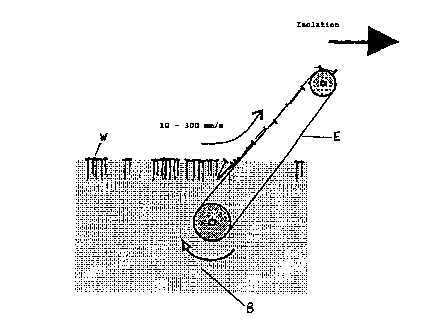Some of the information on this Web page has been provided by external sources. The Government of Canada is not responsible for the accuracy, reliability or currency of the information supplied by external sources. Users wishing to rely upon this information should consult directly with the source of the information. Content provided by external sources is not subject to official languages, privacy and accessibility requirements.
Any discrepancies in the text and image of the Claims and Abstract are due to differing posting times. Text of the Claims and Abstract are posted:
| (12) Patent: | (11) CA 2243002 |
|---|---|
| (54) English Title: | METHOD FOR THE GENTLE ISOLATION OF AQUATIC PLANTS WHICH FLOAT ON THE WATER |
| (54) French Title: | METHODE POUR CUEILLIR EN DOUCEUR DES PLANTES AQUATIQUES FLOTTANT A LA SURFACE DE L'EAU |
| Status: | Expired and beyond the Period of Reversal |
| (51) International Patent Classification (IPC): |
|
|---|---|
| (72) Inventors : |
|
| (73) Owners : |
|
| (71) Applicants : |
|
| (74) Agent: | ROBIC AGENCE PI S.E.C./ROBIC IP AGENCY LP |
| (74) Associate agent: | |
| (45) Issued: | 2003-04-22 |
| (22) Filed Date: | 1998-08-24 |
| (41) Open to Public Inspection: | 1999-03-05 |
| Examination requested: | 1998-11-16 |
| Availability of licence: | N/A |
| Dedicated to the Public: | N/A |
| (25) Language of filing: | English |
| Patent Cooperation Treaty (PCT): | No |
|---|
| (30) Application Priority Data: | ||||||
|---|---|---|---|---|---|---|
|
The invention relates to a method for the gentle isolation from
ponds, basins or containers of aquatic plants which float on the
water. The process according to the invention comprises
a) generating, on the water surface in the pond, basin or
container, a flow which is directed toward the site of
withdrawal, which drives the aquatic plants toward the
site of withdrawal,
b) withdrawing the aquatic plants individually at the site
of withdrawal from the pond, basin or container by means
of a hydrophilic solid or liquid medium, and
c) transferring the aquatic plants individually into
containers.
La présente invention a pour objet une méthode permettant d'isoler et de cueillir en douceur des plantes aquatiques flottant à la surface d'étangs, de bassins ou de réservoirs. La méthode visée par les présentes comporte les étapes suivantes : (a) création, à la surface de l'étang, du bassin ou du réservoir, d'une circulation d'eau dirigée vers un lieu de cueillette désigné vers lequel les plantes sont entraînées; (b) prélèvement individuel des plantes parvenues au lieu de cueillette désigné à la surface de l'étang, du bassin ou du réservoir au moyen d'hydrophiles sous forme solide ou liquide et, (c) transfert individuel des plantes dans des contenants.
Note: Claims are shown in the official language in which they were submitted.
Note: Descriptions are shown in the official language in which they were submitted.

2024-08-01:As part of the Next Generation Patents (NGP) transition, the Canadian Patents Database (CPD) now contains a more detailed Event History, which replicates the Event Log of our new back-office solution.
Please note that "Inactive:" events refers to events no longer in use in our new back-office solution.
For a clearer understanding of the status of the application/patent presented on this page, the site Disclaimer , as well as the definitions for Patent , Event History , Maintenance Fee and Payment History should be consulted.
| Description | Date |
|---|---|
| Time Limit for Reversal Expired | 2004-08-24 |
| Letter Sent | 2003-08-25 |
| Grant by Issuance | 2003-04-22 |
| Inactive: Cover page published | 2003-04-21 |
| Inactive: Final fee received | 2003-02-10 |
| Pre-grant | 2003-02-10 |
| Notice of Allowance is Issued | 2002-08-15 |
| Letter Sent | 2002-08-15 |
| Notice of Allowance is Issued | 2002-08-15 |
| Inactive: Approved for allowance (AFA) | 2002-07-25 |
| Amendment Received - Voluntary Amendment | 2002-05-07 |
| Inactive: S.30(2) Rules - Examiner requisition | 2001-11-09 |
| Application Published (Open to Public Inspection) | 1999-03-05 |
| Letter Sent | 1998-12-09 |
| Request for Examination Received | 1998-11-16 |
| Request for Examination Requirements Determined Compliant | 1998-11-16 |
| All Requirements for Examination Determined Compliant | 1998-11-16 |
| Inactive: IPC assigned | 1998-10-13 |
| Inactive: First IPC assigned | 1998-10-13 |
| Classification Modified | 1998-10-13 |
| Inactive: Filing certificate - No RFE (English) | 1998-09-18 |
| Filing Requirements Determined Compliant | 1998-09-18 |
| Application Received - Regular National | 1998-09-16 |
There is no abandonment history.
The last payment was received on 2002-07-19
Note : If the full payment has not been received on or before the date indicated, a further fee may be required which may be one of the following
Please refer to the CIPO Patent Fees web page to see all current fee amounts.
| Fee Type | Anniversary Year | Due Date | Paid Date |
|---|---|---|---|
| Registration of a document | 1998-08-24 | ||
| Application fee - standard | 1998-08-24 | ||
| Request for examination - standard | 1998-11-16 | ||
| MF (application, 2nd anniv.) - standard | 02 | 2000-08-24 | 2000-07-14 |
| MF (application, 3rd anniv.) - standard | 03 | 2001-08-24 | 2001-07-18 |
| MF (application, 4th anniv.) - standard | 04 | 2002-08-26 | 2002-07-19 |
| Final fee - standard | 2003-02-10 |
Note: Records showing the ownership history in alphabetical order.
| Current Owners on Record |
|---|
| BASF AKTIENGESELLSCHAFT |
| Past Owners on Record |
|---|
| GUNTER RETZLAFF |
| JACOBUS JAN DE KRAMER |